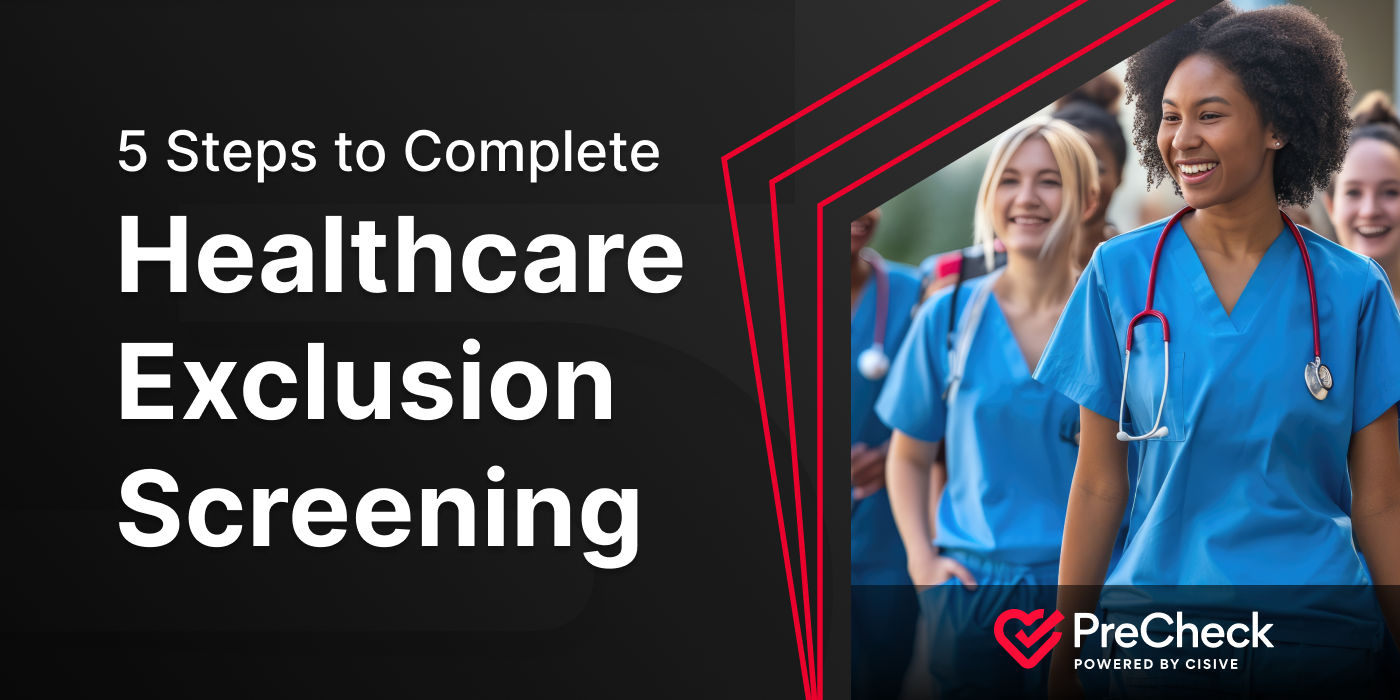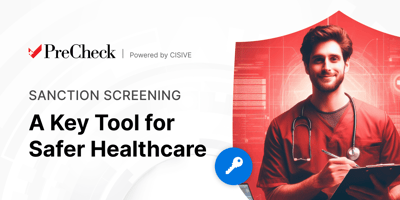

In March, the OIG published a report titled, “CMS’s Process for Sharing Information About...

Whether you work in or recruit for the healthcare industry, hiring qualified employees must be a top priority. To ensure you don’t hire a candidate that’s already proven to pose a real or potential risk to the quality of care, the U.S. Department of Health and Human Services’ Office of Inspector General (OIG) has created a list of excluded individuals and entities (LEIE). Employers who provide services through state or federally-funded health insurance programs, such as Medicare and Medicaid, are banned from hiring or working with any parties on the LEIE list.
Those who violate these regulations could face hefty fines or even lose their ability to provide services under these government programs. Compliance is the employer’s responsibility. Whether an employer or a recruiter, it’s imperative to understand the rules and regulations pertaining to the OIG exclusions list and how to make screening these lists a key component of the hiring process.
This article provides more information about healthcare exclusion screening, why it’s important, and what to do if a candidate or current employee is on this list.
Key TakeawaysHere are the key points to know about exclusion screening.
|
Healthcare exclusions are a list of individuals and entities that are prohibited from participating, either directly or indirectly, in federal healthcare insurance programs.
In basic terms, no person or entity on the OIG exclusion list can provide medical care to patients, either directly or indirectly, for healthcare organizations receiving funds from government healthcare insurance programs, such as Medicare, Medicaid, state-funded Medicare programs, and VA services. This includes doctors, nurses, nursing aides, lab technicians, volunteers, healthcare administrators, and healthcare suppliers and contractors.
The OIG might place a person or entity on the exclusion list for a number of reasons, such as patient abuse, medical fraud, or the distribution of illegal drugs. No matter the reason, the law forbids employers providing Medicare or Medicaid services from hiring anyone on this list.
Recommended Reading: Healthcare Onboarding Tips

In accordance with the Social Security Act, it’s the employer’s responsibility to ensure that new hires and current workers are not on the exclusion list. Employers can’t simply say they didn’t know the candidate was on the exclusion list. It’s each employer’s responsibility to make exclusion screening part of the hiring process.
So, how does healthcare exclusion screening work? There are a few steps involved in the screening process, including:
The first database you want to check is the OIG LEIE list. As an employer, you’re not only required to check the list by the candidate’s legal names but also all relevant names, including maiden names, name diminutives, such as James/Jim, and name combinations, such as Smith-Johnson.
Another list you need to check is the General Services Administration’s System for Awards Management (SAM). This list includes individuals and businesses that cannot work under any type of federal contract, including federally funded healthcare programs.
The Drug Enforcement Agency (DEA) also maintains an exclusion list of names that businesses, including healthcare companies, should not employ.
Employers are also required to check state-level Medicare exclusion lists for all 50 states. This is done to avoid the risk of excluded parties crossing state lines to seek employment.
Exclusion screening is not limited to the hiring process. It must be conducted on an ongoing basis for all workers, volunteers, contractors, and vendors. In fact, healthcare sanctions screening should be done monthly. It’s important to set up a policy of ongoing monitoring to ensure your organization remains in compliance at all times.
Recommended Reading: Drug Testing for Healthcare Professionals

Here is a look at some of the key benefits of conducting healthcare exclusion screening.
Naturally, the most important reason for healthcare exclusion screening is patient safety. The OIG only lists individuals and entities found guilty of a crime or breaking a significant violation, such as fraud, patient abuse or neglect, theft, or fraud. Since these crimes can directly impact patient care, these guilty parties are placed on the OIG exclusion list to ensure they are no longer a threat.
To protect the patients under your care, it’s critical that your company do its due diligence to ensure it doesn’t hire or continue to employ anyone on any of these exclusion lists.
Another key benefit is that an effective exclusion screening process ensures your healthcare facility remains in compliance with state and federal regulations. Otherwise, you risk hefty out-of-compliance fines levied on a per-incident or per-day basis. These fines add up over time, and repeated violations could land your organization on the OIG list. This would forbid your organization from providing services under federal or state Medicare or Medicaid programs.
Comprehensive exclusion screening can also protect your company from liability. Hiring a person on any of the exclusion lists could put your company in jeopardy of one or more lawsuits.
Names don’t just occur on this list by accident. These excluded parties have been convicted of a crime or found guilty of breaking healthcare rules and regulations that could impact patient care, such as patient abuse, medical misconduct, or possession of illegal drugs.
There are two levels of OIG exclusions: mandatory and discretionary. Mandatory exclusions, such as Medicare and Medicaid fraud or patient abuse and neglect, come with mandatory exclusion time frames that range from 5 to 10 years. Those with multiple offenses risk facing an indefinite exclusion.
On the other hand, discretionary offenses come with no mandates. Instead, the OIG has the freedom to set the exclusion period based on the offense. Exclusion periods are typically assigned for lesser offenses, such as misdemeanors, usually lasting 3 years.
Names on the OIG list are not automatically removed from the database. Instead, individuals and entities must submit a formal request to the OIG for reinstatement. Only once the excluded party receives a certificate of reinstatement can they work in the healthcare industry again.
Recommended Reading: Healthcare Background Check Requirements
If there is a hit on any of the healthcare sanctions screening reports for a new hire or current employee, your first step is to verify that it’s the same person. It’s possible that someone else with the same name may be on the exclusion list, not your applicant. Use other criteria, such as date of birth, social security number, or taxpayer identification number (TIN), to ensure it’s the same person applying for a job with your company.
If you’ve confirmed the person is on the list, it’s time to contact your attorney. You may need to contact the candidate to explain why you cannot hire them, terminate the new hire or even current employee, or suspend the employee until they can officially have their name removed from the exclusion list. You can also self-report the conflict to protect your organization.
An attorney specializing in healthcare law can walk you through this process and determine the appropriate steps for your specific situation. Taking proactive measures from the beginning can prevent costly fines later on.
Exclusion screening is not a practice your company can just consider. It’s a necessary step to avoiding hefty fines or losing your ability to process claims through Medicare and Medicaid. Most importantly, exclusion screening is an extra precaution to help keep your patients safe.
Screening all new hires and conducting monthly exclusion screenings for your workers can be tedious and time-consuming, especially considering that you must check all 50 state Medicare exclusion lists. In fact, depending on the size of your company, manual exclusion screening can be impossible.
That’s why our teams at PreCheck offer continuous monitoring services to keep your organization in compliance. Instead of manually checking every database, our comprehensive healthcare exclusion screening software can check all required databases in seconds. In addition, our thorough background checks, employment and education verifications, and drug testing can significantly improve hiring outcomes.
Learn more about our exclusion screening services and how we can help your company remain in compliance with OIG requirements.
Speak to an expert today to learn more.

In March, the OIG published a report titled, “CMS’s Process for Sharing Information About...

Healthcare organizations are responsible for ensuring they hire trustworthy employees and engage in...

As an organization in the healthcare industry, remaining in compliance with the rules and...